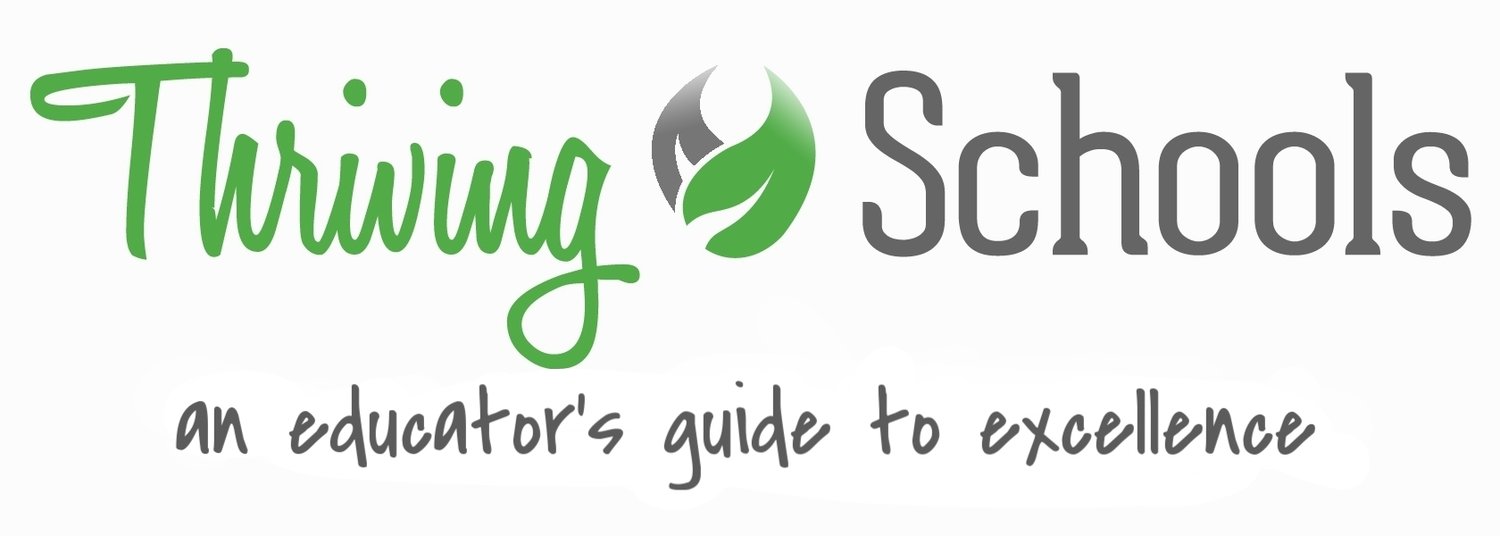Defining Excellence in Teaching with Shyam Kumar
/Shyam Kumar is the Founder and CEO of NorthStar Education Partners. Over the last several years, Shyam has led initiatives in multiple charter networks and districts to develop teacher and leader career-pathway programs focused on increasing staff development, impact, and retention. Shyam’s work has included defining excellent student and school outcomes, integrating coaching and evaluation processes and developing extended reach teaching roles to expand the impact of high performing teachers. Previously, Shyam served as the Executive Director of Teach for America – Atlanta and has worked as a management consultant at GE. Shyam resides with his family in Atlanta, GA.
Defining Excellence in Teaching
Thriving Schools: In the first part of our interview, you described how defining excellence in teaching was so important to improving teacher retention. What is your process for doing this?
Shyam: First, a school needs to form the right team – a diverse set of school leaders and teachers – that have different levels of experience, but who all have a really high internal bar for excellent teaching. Get them around the table and have them brainstorm around questions like – “When you walk into a classroom what does excellent instruction for kids look like?” “What should students to be doing to know that excellent instruction is taking place?”
Thriving Schools: Why are you framing these questions in terms of student outcomes?
Shyam: We spend too much time thinking about what the teacher is doing. Student outcomes are more important because we want to make sure teacher actions are translated into tangible, student results. Examples of this might include: “students are doing the majority of thinking,” “kids are owning the classroom routines and systems,” or “students are checking each other’s work because they’re deeply invested in their learning.” I think it’s important for all school teams to go through this process because there simply isn’t a one-size-fits-all answer to these questions.
Thriving Schools: What else should school teams keep in mind during these formative meetings?
Shyam: This process should also involve thinking about how the team wants their definition of excellence to look. Not every school will want a 5-10 page rubric that they have to follow. Some will want a list of recommended instructional practices. But once that’s on paper and there’s consensus throughout the organization, the next body of work is norming and aligning around the definition of excellence. This involves getting video of excellent instruction and watching it. From there, you’ll be able to discuss how that instruction compares to your team’s vision of excellence and where your teachers may need further support.
Thriving Schools: If school teams or leaders wanted examples of organizations who’ve done a good job with this, where would you direct them?
Shyam: TNTP has an excellent rubric which they call their Core Teaching Rubric and I like it for several reasons (when clicking on the link, the download is at the bottom of the page; the resource is free, but you must agree to the Creative Commons license). First, it’s student focused. Next, it’s much shorter (and thus easier) to use than a lot of the others out there. Achievement First has a good one that I believe is based on the TNTP rubric. And then I also like the work that DC Public Schools has done. So these would be excellent starting points.
Extended Teaching Roles and Distributed Leadership
Thriving Schools: Shifting gears, you’ve also done a lot of thinking around extended teaching roles (positions that schools create to give their best teachers additional coaching or content responsibilities). What advice do you have on designing these?
Shyam: I think the best extended teaching roles do a few things. First, they must be aligned to the school or district’s core strategy or vision. For example, if a district has a priority of having teacher-leaders provide content expertise, then the extended teaching role should do just that. On the other hand, if a school has a priority of using data to drive instruction, then they should be providing training and support there. The next thing is making sure the school conditions are right. This means that if you’re asking teachers to take on additional work, you’re reducing their teaching load. This makes it very important to be clear about what a given role entails and how individuals are selected for them.
"School leadership is too broad and involves too many activities to expect principals and assistant principals to do it all on their own. So pushing down responsibility to teachers as far as you can is a very powerful idea."
Thriving Schools: Would you add anything else to the list?
Shyam: I also believe that if you’re asking teachers to take on more work, that you’re providing additional compensation for it. And the last piece I’ll mention is ongoing support and development for these teachers. Just because they’re in a teacher-leader role doesn’t mean their desire to grow and get better has gone away.
Thriving Schools: Where does real-time, job-embedded coaching fit into this?
Shyam: It’s very important. Coming back to a point I mentioned last time, there simply aren’t enough coaches that have deep content knowledge. But that also means there’s a perfect fit here for using extended teaching positions. We simply take a highly effective teacher who has that deep content knowledge and give them the opportunity to impact other teachers in the same subject area.
Thriving Schools: And do you have any good examples of schools or districts doing this?
Shaym: Yes! Denver Public Schools (and many others) are using the language of distributed leadership. They’re coming to the obvious, yet elusive, conclusion that school leadership is too broad and involves too many activities to expect principals and assistant principals to do it all on their own. So pushing down responsibility to teachers as far as you can is a very powerful idea.
Thriving Schools: Coming back to a point you made just a moment ago – how do you strike the right balance between distributing new responsibilities to teachers while still maintaining a reasonable amount of work?
Shyam: While a part of this is trial and error, I do think enough schools have experimented with these types of roles that we have some good guidelines. The first part is doing the math. For example, if we’re expecting a teacher-leader to coach 3 teachers, we have to account for several new items that will take up their time. We might have to account for 30-minute observations, time to document those observations, and perhaps 30-45 minutes of debriefing. Then you multiply that by how many teachers they’re coaching and how frequently they’re doing the coaching. And then don’t forget to build in time for these coaches to receive support and to be developed themselves. We already know teachers are at 120% of capacity, so if we ask them to do more we’d better find the time for them to do it.
Thriving Schools: I think you’d agree that everyone in a school setting feels like they’re operating at 120% of capacity! And at some point, all that work needs to get done. So what 1 or 2 levers do you like to pull on to make this equation balance?
Shyam: I think this depends on the context. Because for a small CMO, the staffing will already be lean and you’ll likely have just 1 or 2 teachers per grade level or area of content. So in this setting, it becomes really hard. But I’ve seen schools make use of teacher residency programs or hiring an extra teacher that has the ability to float. In the more traditional district settings, though, I’ve found there are good tradeoffs that are available. For instance, if you have 3 AP’s in a traditional middle school, you might decide that trading 1 of those for 3 teacher-leaders (in terms of stipends and relief time) will better allow you to push for instructional excellence. I do think larger district schools have the staffing to make this happen if it’s a priority.
Staff Development and Resources
Thriving Schools: In schools where teachers are taking on more roles and responsibilities, how does leadership ensure everyone’s receiving the right amount of development? Do you have any frameworks for thinking about this?
Shyam: Absolutely. One idea is aligning your teachers’ development to the 70/20/10 plan for adult learning. And just so you know, this is a reference to what research shows is the best way for adults to learn – 70% happens on the job (by actually doing the work and discovering novel and more effective approaches to doing things), 20% comes from being coached, and 10% comes from increasing knowledge (going to a conference or reading books on a particular topic). So let’s say you have a teacher who’s never managed a group before but is ready for a “stretch” responsibility. You might decide to place them in charge of an after-school initiative. In terms of their development, you should expect 70% of their growth to come from actually doing the work (and what they learn along the way), 20% might come from an AP who will coach them and help them get better, and the last 10% might be reading up on how to build a team and achieve goals. It’s a really simple framework to think about how to transition teachers into new leadership positions while making sure they feel supported.
Thriving Schools: To wrap up, are there any other books or resources that you’d recommend to our network of educators on the ideas we’ve covered in this conversation?
Shyam: In my opinion, there are 2 must-reads. The first one is the book Drive by Daniel Pink. It’s an amazing book that really gets to the core of what motivates us as human beings. The second one is called Talent Masters. And that book really gets to the core of building systems that help people stay engaged and stay in their work. A few other items readers may want to check out are the TNTP reports on Greenhouse Schools and The Irreplaceables.


